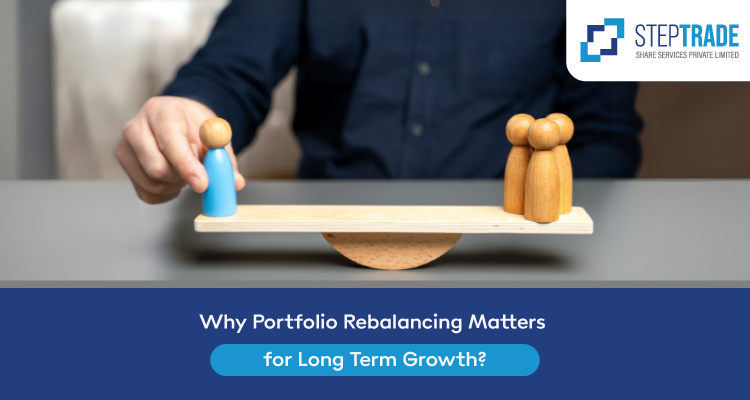Long-term investing is a journey that requires careful planning and consistent strategy. As markets evolve and asset classes perform differently over time, it helps manage risk and increase returns by maintaining the right balance between different asset classes.
One critical strategy to ensure your portfolio remains aligned with your goals is portfolio rebalancing. Rebalancing is the process of adjusting the mix of assets in your portfolio to bring it back in line with your desired allocation. It helps manage risk and optimize returns by maintaining the right balance between different asset classes.
In this blog, we will explore the importance of portfolio rebalancing, how it helps manage risk, and why it is especially crucial for investors focusing on high-growth segments like SME, microcap, and AIF investments. By understanding rebalancing, you can take proactive steps toward achieving long-term financial success.
What Exactly is Portfolio Rebalancing?
Portfolio rebalancing is the process of realigning the weightings of assets in your investment portfolio. As markets fluctuate, some assets outperform others, causing your original asset allocation to shift. Rebalancing helps maintain your target risk level by systematically adjusting the asset mix back to its intended structure.
Rebalancing ensures that your investment strategy stays disciplined and consistent over time. Instead of letting short-term performance distort your portfolio's risk profile, it restores balance based on long-term objectives. This is particularly important in high-volatility segments like SME and microcap investing, where imbalances can grow more quickly and lead to overexposure.
Why Does Portfolio Unbalance Overtime?
Asset prices don’t rise or fall uniformly. Some sectors or asset classes outperform, while others underperform, leading to an imbalanced portfolio. This can particularly affect portfolios concentrated in high-growth segments like SMEs or microcaps.
- Performance Disparity: When one asset class outperforms others, it can unbalance your portfolio, increasing exposure to a single type of asset unintentionally.
- Sector-Specific Surges: Rapid growth in specific sectors may tilt your portfolio, leading to concentration risk and reduced diversification over time.
- Currency Volatility (for NRIs): Fluctuations in exchange rates can impact the value of overseas investments, especially for NRIs holding foreign assets.
- Investor Sentiment: Shifts in sentiment often drive investors to chase trends, resulting in misaligned allocations and unintended portfolio risks.
| Asset Class | Expected Allocation | Drifted Allocation | Risk Implication |
|---|---|---|---|
| SME Equity | 40% | 55% | Increased volatility |
| AIF | 30% | 20% | Missed growth opportunities |
| Debt | 30% | 25% | Reduced portfolio stability |
How Rebalancing Supports Long-Term Growth?
Portfolio rebalancing is not a reactive move—it’s a proactive strategy that reinforces long-term discipline, particularly in volatile and high-growth investment segments like SMEs and microcaps.
- Controls Portfolio Risk:
Rebalancing curbs the risk of overexposure by realigning asset weights to their intended levels. This mitigates the impact of a single asset class dominating the portfolio and helps preserve overall risk tolerance across changing market conditions. - Locks in Profits :
By periodically selling assets that have appreciated significantly, investors can realize gains before market corrections occur. This strategy helps investors realise gains without relying on market timing. - Enables Value Investing :
Rebalancing encourages reinvestment into undervalued or underweighted assets. This aligns with value investing principles—buying assets when they're attractively priced—which can lead to stronger returns as these assets recover or grow over time. - Removes Emotional Bias :
It instills a rules-based discipline that counters the urge to chase performance or panic during downturns. It replaces reactive decisions with a rules-based approach. - Fuels Compounding :
A consistently balanced portfolio ensures reinvested earnings remain aligned with strategic goals. Over time, this reinforces the power of compounding, where reinvested gains generate their own returns, accelerating wealth accumulation sustainably.
How Often Should You Rebalance the Portfolio?
Rebalancing isn’t a one-size-fits-all concept. Investors may choose between time-based or threshold-based methods, depending on asset class volatility and personal strategy.
- Time-Based Rebalancing: Time-based rebalancing follows a predetermined schedule, such as semi-annually or annually. It ensures your portfolio remains aligned with your long-term goals, regardless of short-term market movements.
- Threshold-Based Rebalancing: Threshold-based rebalancing is triggered when an asset class deviates beyond a set percentage from its target allocation. For instance, if an asset allocation shifts by ±5%, the portfolio is rebalanced to bring it back in line with the original strategy.
- Blended Approach: The blended approach combines both time-based and threshold-based rebalancing. By reviewing the portfolio at set intervals while also reacting to significant market shifts, it offers a flexible yet disciplined strategy.
Why Rebalancing is Important for SME & Microcap Portfolios
SME and microcap investments carry distinct characteristics that heighten the importance of regular rebalancing.
- Higher Volatility:
SME and microcap stocks tend to experience sharper and more frequent price swings. These fluctuations can skew asset allocations rapidly, increasing exposure to risk and requiring timely rebalancing to maintain portfolio stability and control downside movements. - Concentration Risk:
Portfolios in this segment often include a limited number of high-conviction picks. If a few stocks outperform significantly, they can dominate the allocation, reducing diversification benefits and increasing vulnerability to sector-specific corrections or adverse company events. - Rapid Growth Potential :
These assets are capable of delivering exponential gains in short periods. While attractive, this rapid appreciation can unbalance portfolios, concentrating exposure to sectors or themes that may not align with long-term strategy without corrective rebalancing.
Without rebalancing, these portfolios can evolve into high-risk positions, misaligned with the investor’s original intent.
Should You Rebalance During Market Volatility?
Market volatility often causes investors to hesitate, but this is precisely when rebalancing can deliver significant value.
- Preserves Risk Profile : Ensures your exposure doesn’t increase unintentionally as prices fluctuate.
- Disciplined Amid Chaos : Provides a logical decision-making framework, avoiding panic-driven actions.
- Identifies New Opportunities :
Volatile periods may offer attractive entry points into undervalued sectors or stocks.
That said, rebalancing during uncertainty requires careful analysis of long-term fundamentals—not short-term trends. However, execution must be supported by long-term conviction, not fear or speculation.
Conclusion
Portfolio rebalancing is a core discipline in investment management. For SME, microcap, and AIF investors, it helps navigate volatility, safeguard capital, and align strategy with growth objectives. It isn’t about reacting to the market—it’s about staying aligned with your long-term vision.
At Steptrade Capital, we integrate rebalancing into every portfolio we manage, applying a data-driven approach tailored to the nuances of SME and microcap markets. Our proactive rebalancing process helps investors stay the course while optimizing for sustainable growth.
Ready to realign your investments for long-term performance?
Explore how Steptrade’s portfolio strategies can help you manage risk and capitalize on emerging opportunities. Visit Our Websiteor contact us for a consultation.














